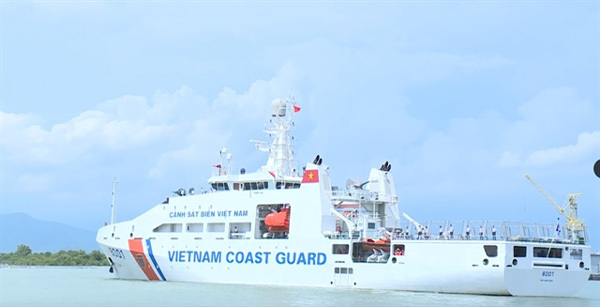PM issues plan on implementation of Law on Vietnam Coast Guard
Six patrol boats transferred to Vietnam coast guard by the US
Vietnamese, Indian coast guards step up cooperation
 |
| The Viet Nam Coast Guard has frequently used its rights to fight and prevent acts of infringing upon Vietnamese waters, illegal fishing, research, exploration of oil and gas and minerals, smuggling, trading and transporting illegal goods on the sea as well as repressing pirates and armed robberies. VNA/VNS Photo |
What are the main contents of the Law on Viet Nam Coast Guard?
The law stipulates the position, functions, duties, powers, organisation, operation and policies for the Coast Guard; as well as responsibilities of relevant agencies, organisations and individuals.
This regulation is newer and clearer than the 2008 ordinance and has overcome the inadequacies of the current legal system, which does not have regulations on measures for the coast guard’s activities.
It provides clearer regulations on international co-operation of the Viet Nam Coast Guard, which creates an open and favourable legal framework to carry out national coastal responsibilities in accordance with the international treaties to which Vietnam is a member.
According to the Law, the Viet Nam Coast Guard has the right to pursue boats in the sea. Can you tell more clearly about this?
The Viet Nam Coast Guard has frequently used its rights to fight and prevent acts of infringing upon Vietnamese waters, illegal fishing, research, exploration of oil and gas and minerals, smuggling, trading and transporting illegal goods on the sea as well as repressing pirates and armed robberies.
Chapter three of the law has specific and clear regulations on the order, procedures and competence of the Viet Nam Coast Guard in each activity such as patrol, inspection and control; mobilising manpower, boats, civil means; exercising the right to pursue ships at sea; use of weapons, explosives, support tools; using facilities and technical equipment; announcing maritime security levels and so on.
What are the regulations on the responsibilities and policies for participating agencies, organisations and individuals, assisting the Coast Guard?
As we operate in large seas, with severe weather conditions and difficulties, in many cases, it requires the participation, co-ordination, support and assistance of agencies, individuals and organisations to perform their tasks.
The new law has specific provisions to ensure policies for organisations and individuals supporting the Viet Nam Coast Guard as stated in Article 6, which stipulates responsibilities and policies for agencies, organisations and individuals to participate, co-ordinate, collaborate, support and assist the force, and Article 16, which stipulates the mobilisation of people, boats and means and civil engineering equipment of the Viet Nam Coast Guard.
How has the law been implemented?
Coast Guard Command has researched and compiled two decrees, two circulars and two decisions of the Minister of National Defence detailing and guiding the implementation of the law; ensuring the progress and quality according to the drafting plan of the Government and the ministry.
The Coast Guard Command has developed a dossier on dissemination of the law in the period of 2019-22. The plan is to focus on disseminating the law cadres, soldiers and staff of ministries, departments and branches, ensuring that all people get the information and basic contents of the law.
Currently, the Coast Guard Command is developing a plan to consolidate, rearrange and restructure the training centre of the Viet Nam Coast Guard. It is expected to be submitted to the Prime Minister in the third quarter of 2020.
What are difficulties during the implementation of the law?
It is the highest legal document which creates a solid basis to improve operational efficiency, meeting the task requirements in the new situation.
It facilitates the Viet Nam Coast Guard to protect, help and support the Vietnamese people to do business legally at sea as well as help Vietnamese fishermen operating in Vietnamese and international waters.
However, the reality also shows many difficulties in implementing the law. Firstly, it has wide scope of adjustment and application objects on position, function and duty for the Viet Nam Coast Guard.
The issue of human resources training to build and develop the revolutionary, formal, elite and modern Viet Nam Coast Guard is also a certain difficulty.
Another difficulty is the implementation of synchronous co-ordination and effective activities between the Viet Nam Coast Guard and functional forces of ministries, branches, people's committees of provinces and cities.
VNS
 Coast Guard Commander Lieuternant General Nguyen Van Son Viet Nam, talks to the Vietnam News Agency about a new law which took effect this month.
Coast Guard Commander Lieuternant General Nguyen Van Son Viet Nam, talks to the Vietnam News Agency about a new law which took effect this month.